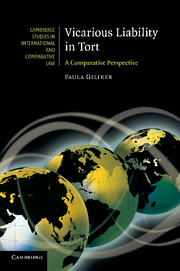Book contents
- Frontmatter
- Contents
- Diagrams
- Table of cases
- Table of legislation
- Preface
- 1 What is vicarious liability?
- 2 Establishing a general framework for liability
- 3 The employer/employee relationship: identifying the contract of employment
- 4 Special difficulties: borrowed employees and temporary workers
- 5 Other relationships giving rise to liability
- 6 Acting in the course of one's employment/functions/assigned tasks: determining the scope of vicarious liability
- 7 Parental liability for the torts of their children: a new form of vicarious liability?
- 8 Understanding vicarious liability: reconciling policy and principle
- 9 A postscript: a harmonised European law of vicarious liability?
- Appendix: Key provisions of the French and German Civil Codes
- Index
- Titles in the series
4 - Special difficulties: borrowed employees and temporary workers
Published online by Cambridge University Press: 10 November 2010
- Frontmatter
- Contents
- Diagrams
- Table of cases
- Table of legislation
- Preface
- 1 What is vicarious liability?
- 2 Establishing a general framework for liability
- 3 The employer/employee relationship: identifying the contract of employment
- 4 Special difficulties: borrowed employees and temporary workers
- 5 Other relationships giving rise to liability
- 6 Acting in the course of one's employment/functions/assigned tasks: determining the scope of vicarious liability
- 7 Parental liability for the torts of their children: a new form of vicarious liability?
- 8 Understanding vicarious liability: reconciling policy and principle
- 9 A postscript: a harmonised European law of vicarious liability?
- Appendix: Key provisions of the French and German Civil Codes
- Index
- Titles in the series
Summary
Introduction
This chapter will address two particular issues arising from the requirement of an employer/employee relationship: which employer will be responsible for the wrongful acts of an employee currently on loan to a temporary employer, and who, if anyone, will be responsible for the wrongful acts of casual or agency staff. These raise distinct, if overlapping, concerns. In both situations, the worker is engaged in temporary work, often for a short period of time, and his relationship with the temporary employer does not bear the traditional hallmarks of a contract of employment. However, in the first situation, the question is not whether the worker is employed, but whether the general or temporary employer will be vicariously liable for his wrongful conduct. Here, the courts have sought to provide some degree of certainty by resort to presumptions of liability and, in more recent times, attempted to find a test consistent with the policy rationales underlying the imposition of vicarious liability. Atiyah in 1967 presented a more radical solution: rather than choosing between the general and temporary employer, policy would suggest that the best approach would be to render both employers liable, thus ensuring the victim compensation without having to predict which employer would be held liable at law. This approach has not generally been adopted by the courts.
The second situation raises more fundamental problems in that the casual worker, supplying his labour on demand, either directly or via an employment agency, resembles an independent contractor, not an employee.
- Type
- Chapter
- Information
- Vicarious Liability in TortA Comparative Perspective, pp. 81 - 100Publisher: Cambridge University PressPrint publication year: 2010



